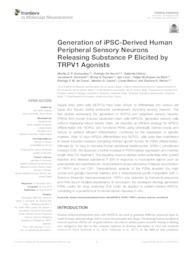Generation of iPSC-derived human peripheral sensory neurons releasing substance P elicited by TRPV1 agonists.
Generation of iPSC-derived human peripheral sensory neurons releasing substance P elicited by TRPV1 agonists.
Author(s): GUIMARÃES, M. Z. P.; DE VECCHI, R.; VITÓRIA, G.; SOCHACKI, J. K.; PAULSEN, B. S.; LIMA, I.; SILVA, F. R. da; COSTA, R. F. M. da; CASTRO, N. G.; BRETON, L.; REHEN, S. K.
Summary: Neural crest stem cells (NCPCs) have been shown to differentiate into various cell types and tissues during embryonic development, including sensory neurons. The few studies addressing the generation of NCPCs and peripheral sensory neurons (PSNs) from human induced pluripotent stem cells (hiPSCs), generated sensory cells without displaying robust activity. Here, we describe an efficient strategy for hiPSCs differentiation into NCPCs and functional PSNs using chemically defined media and factors to achieve efficient differentiation, confirmed by the expression of specific markers. After 10 days hiPSCs differentiated into NCPCs, cells were then maintained in neural induction medium containing defined growth factors for PSNs differentiation, followed by 10 days in neonatal human epidermal keratinocytes- (HEKn-) conditioned medium (CM). We observed a further increase in PSN markers expression and neurites length after CM treatment. The resulting neurons elicited action potentials after current injection and released substance P (SP) in response to nociceptive agents such as anandamide and resiniferatoxin. Anandamide induced substance P release via activation of TRPV1 and not CB1. Transcriptomic analysis of the PSNs revealed the main dorsal root ganglia neuronal markers and a transcriptional profile compatible with C fiber-low threshold mechanoreceptors. TRPV1 was detected by immunofluorescence and RNA-Seq in multiple experiments. In conclusion, the developed strategy generated PSNs useful for drug screening that could be applied to patient-derived hiPSCs, consisting in a powerful tool to model human diseases in vitro.
Publication year: 2018
Types of publication: Journal article
Observation
Some of Embrapa's publications are published as ePub files. To read them, use or download one of the following free software options to your computer or mobile device. Android: Google Play Books; IOS: iBooks; Windows and Linux: Calibre.
Access other publications
Access the Agricultural Research Database (BDPA) to consult Embrapa's full library collection and records.
Visit Embrapa Bookstore to purchase books and other publications sold by Embrapa.

